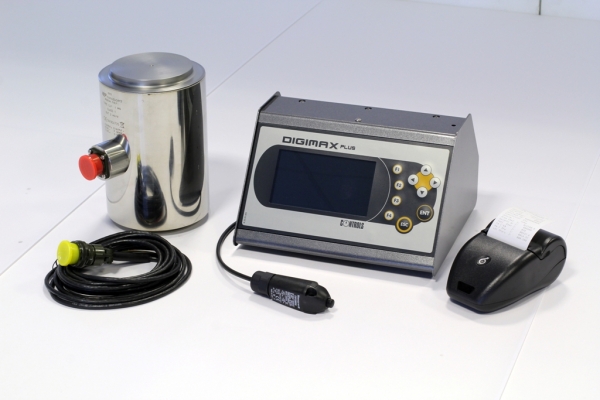In the force calibration laboratory based on the scope of certification and national and international standards of tensile calibration and compression dynamometer calibration, load cell calibration, material testing machine calibration and speed and displacement measuring device and extensometer calibration inside the company and at the customer site Experienced and trained experts are calibrated.
Most of the time it is necessary to measure the forces acting on an object in industrial centers and workshops. For example, to control the stability of a bridge that thousands of cars pass through every day, we must calculate the number of forces that are applied to it. To measure the forces acting on an object, converters called dynamometers are used. By measuring the amount of strain based on the change in rod length and according to the coefficient of elasticity, the force applied to the body can be calculated.
To measure the amount of strain generated in the body, a strain gauge is used, which is one of the resistance sensors. Strain gauges are used to measure force, pressure, torque and weight. Resistance strain gauges are thin layers of resistance wires that are mounted on the components of a machine or structure with special adhesives. Due to the force applied to the strain gauge, the length of the resistance wires increases (due to tension) or decreases (due to compression). The thickness of the wires changes due to pressure or tension. In strain gauges, there is a linear relationship between the applied force and the resistance change.
Today’s dynamometers usually include 4 strain gauges that are placed in a full bridge circuit that includes the following types of load cells:
Load single base cells
Features of single base load cells:
- Capacities: 3, 5, 6, 8%, 40 and 50%. 500 kg
- Material: Aluminum alloy
- Maximum loading plate dimensions: Accuracy class
- Applications of single base fertilizer:
Single base scales
- Industrial scales for hazardous environments
- Medical scales
- Label printing scales
- Postal scales
- Weighing packing and filling machine
- Weighing single base conveyor:
- Weighing conveyor
- Weight controller
- Roller weighing
Load of flexural and shear cells:
Shear beam load cells are commonly used in buckets, scales and weighing systems and carcasses. These load cell models must be used in multiples.
Features of flexural load cells:
- Material: Nickel plated steel
- applications:
- Multi-base scales
- Floor scales
- Movable floor scale
- Medical scales
- Industrial scales for high-risk environments
- Animal scales
- Weighing silos and tanks
- Ceiling weighing
- Medical equipment
- Elevator
- Overhead Cranes
- Weighing pallets
- Weighing pallets with jacks
- U-shaped palette
- Pallet with jack
Two-way bending load cells
Features of double-sided bending load cells:
- Capacity: 10, 20, 25 and 50 tons
- Material: Steel alloy
- Applications of double-sided bending load cells:
- Weighbridge
- Train
- Portable truck
- Truck puller
- Cache axis
- Weighing silos and tanks
- For high-risk environments
S-shaped load cells
The appearance of this load cell is similar to S. The mechanism of action of this load cell is also based on length changes. One side of the load cell is connected to a fixed point from the top and force is applied to it from the bottom. This type of load cell is often used in suspension weighing systems. They are one of the most widely used load cells and are used in systems that are both tensile and compressive in nature.
Features of s-shaped load cells:
- Capacity: 50, 100, 250 and 500 kg… 1 to 10 tons
- Material: Nickel plated steel
- Applications of s-shaped load cells:
- Ceiling weighing
- Pendant scales
- Wireless crane scales
- Crane scales at high temperatures
- Weighing batching and mixing
- Food industry
- Concrete factory
Compression load cells
Includes subcategories:
Canister Barrel Compression Load Cells: They are used in batching systems, road scales, trains, tank weighing and heavy weighing systems in general.
Low Profile Miniature Compression Load Cell: Used in places where space is limited and also for delicate applications.
Single point compression load cell: The function of these load cells is in the form of point point and they are used as single.
Attributes:
- Capacity: 30, 40, 50 and 60 tons
- Material: 316 steel
- applications:
- Weighbridge
- Weighing silos and tanks
- Power Calibration – Special Load Cells
Power calibration:
Various load cells with special applications are in this group. Such as wire and cable load estimating load cells, torque sensor, x-axis, x-axis sensor, weighing plates and…
applications:
- Ceiling weighing
- Weighing pendant
- Measurement of force or pressure
- Weighing mobile device
- Single base scales
- Weighing packing and filling machine
- Measurement of traction or pressure
Some of the parameters that are very important in comparing load cells are listed below:
Maximum safe load EMAX, operating temperature range, input voltage range, minimum measurable value, rated output, input power, output resistance, output error, zero error, composite error, repeatability error, creep
Important parameters in identifying and comparing load cells
Electrical safe limit, maximum safe load (mechanical), corrected temperature range, operating temperature range, warehouse temperature range, excitation input voltage range, minimum measurable value, nominal output, input ohmic resistance, output ohmic resistance, Output error, zero error, compound error, repeatability error, creep, temperature effect on load cell sensitivity (no load)
Brands We Work With












#Calibration #Force #CalibrationForce #Measurement

